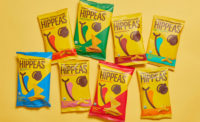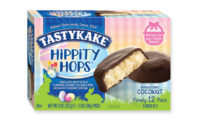Puffed and extruded snacks cover a lot of ground: from cheese snacks to multigrain chips and pork rinds, they dominate the snack aisle. And they span a wide range of snacking occasions, from fun and indulgent to mindfully better-for-you.
Overview | Chips | Puffed/Extruded Snacks | Popcorn | Snack Mixes & Nuts | Tortilla Chips | Pretzels | Frozen Snacks | Crackers
Market data
According to IRI, Chicago, for the 52 weeks ending May 31, 2019, the massive salty snacks category grew 4.9 percent to a value of $24.9 billion. The multiple segments that encompass puffed and extruded snacks were responsible for approximately $9 billion of that haul.
The largest of these segments, “other salted snacks (no nuts)”—where products like Funyuns, SunChips and Pirate Booty find a home—was up by a healthy 8.0 percent, growing to $4.7 billion, per IRI. Every company in the top five for this segment saw some level of growth for the year. Frito-Lay brand Funyuns was up 7.7 percent to $408.4 million. The company’s Chester’s brand encompasses products like “fries” and puffcorn and was up 9.9 percent to $319.3 million. Its SunChips brand saw notable 14.6 percent growth to $286.5 million. It’s Lay’s Poppables brand also continued strong growth, up 38.5 percent to $103.2 million. Pirate Booty, now a Hershey Co. brand, grew 3.8 percent to $96.0 million.
The cheese snacks segment took in $2.5 billion, an increase of 9.6 percent. Frito-Lay’s Cheetos brand reigns here, up 6.2 percent to $1.8 billion. Simply Cheetos grew 51.4 percent to $91.2 million—a strong example of the power of clean label. Similarly, Cheetos Oven Baked was up 61.3 percent to $26.6 million showing continued appeal for better-for-you versions of classic snacks. The segment overall is strong, with all top five companies showing growth. Arthur Schuman Inc. broke into the top five this year with its Cello Whisps brand, up a whopping 151.8 percent to $31.5 million.
The corn snacks category grew 2.8 percent to $1.2 billion for the year. While Frito-Lay brands dominate—with Fritos, Fritos Scoops and Fritos Flavor Twists accounting for nearly 75 percent market share—other brands are making waves. PopCorners from BFY Brands skyrocketed 474.3 percent to $2.3 million.
The pork rinds segment saw very nice growth, up 17.1 percent to $560.1 million, per IRI. Frito-Lay leads with its Baken Ets line, up 7.4 percent to $141.9 million. Top growth came from private label, up 75.9 percent to $32.9 million. The Rudolph Foods brand Southern Recipe showed a 66.2 percent increase to $8.7 million, and is expanding its appeal through its Southern Recipe Small Batch line. And upstart 4505 Chichharrones from 4505 Meats—which bills its pork rinds as “Paleo certified”—showed a staggering 255.9 percent increase, bringing in $4.5 million in sales.
Looking back
“Today, we are seeing a broadening of the puffs and extruded snacks category, due in part to consumer demand for better-for-you foods,” says Mark Singleton, vice president of sales and marketing, Southern Recipe Small Batch, Rudolph Foods, Dallas. “The food industry has taken note of the cooking and shopping patterns of the present-day shopper and found that snacking is a perfect fit for today’s busy lifestyle. However, portable snacking isn’t enough.” Southern Recipe Small Batch offers a line of upscale pork rinds that have a lower fat content than typical pork rinds in flavors like Blackberry Habanero and Korean Kimchi BBQ—most recently releasing a Small Batch variety pack of single-serve packages.
New products often reflect better-for-you and/or clean-label trends. In November 2018, Puffworks released its Baby Organic Peanut Butter Puffs, geared toward infants and toddlers. Harvest Snacks, which boasts crisps free from artificial flavors, colors, cholesterol and common allergens (soy, nuts, wheat and eggs), released Southern Style BBQ Black Bean Snack Crisps and White Cheddar Green Pea Snack Crisps back in November, as well.
Jared Johnson, vice president of insights and analytics, Frito-Lay North America, Plano, TX, has noticed demand for new snack formats beyond potato and corn, leading to interest in plant-based, high-protein ingredients like legumes. The company’s Veggie Puffs products, part of the plant-based Off the Eaten Path product line, offer 5 grams of protein per serving thanks to primary ingredients like chickpeas and green and yellow peas.
Nick Desai, CEO, World Peas Brand Peatos, Los Angeles, notes that the consumer desire to eat better is trending—whether it’s making small adjustment by looking for cleaner ingredients, nothing artificial, or adding more protein and fiber into their diets. “The other broad trend we are seeing is an overall interest in alternative ingredients like cauliflower, peas, lentils, cassava and other vegetables.” But consumers increasingly won’t trade taste and experience for better health.
Peatos expanded its lineup with a new Ranch flavor in March 2019. The puffed snack is made from peas and lentils, offering good levels of protein and fiber.
HIPPEAS released its new Nacho Vibes and Himalayan Happiness flavors in February 2019. HIPPEAS are made out of chickpeas, and are organic, non-GMO, gluten-free, vegan and baked.
Another top trend are extruded, fried corn curls, says Don Giles, director of sales, processing systems, Heat & Control, Hayward, CA. “This category is growing quickly, and manufacturers are responding by steadily increasing the capacity of their systems.”
Gilles Maller, vice president sales and international, Clextral, Tampa, FL, says that clean labels with authentic ingredients, as well as plant-based snacks, were the most popular this year. He also says that new twists on flavors with regional and ethnic influences, as well as sweet/savory flavor combinations, are popular.
Southern Recipe Small Batch released a new Thai Style Curry flavor of pork rinds in March 2019. It also released Cuban Mojo Pork Cracklins, which blends citrus and Caribbean spices.
“Other top trends include snacks with textures that deliver unexpected sensory experiences—super crunchy, ultra-light, dual-textured snacks with flavored fillings,” adds Maller. “As busy consumers are eating snacks as meal replacements, snacks with added nutrition from vegetables—mushrooms, peas, cauliflower, broccoli—and root vegetables like sweet potatoes, cassava, carrots, beets and onions—will also be popular.”
Looking forward
Maller says that consumers are looking for alternative sources of proteins, and plants are a good option with a lower environmental footprint versus animal proteins. “Plant-protein-enriched snacks allow consumers to merge the ‘feel good for the planet and my health’ with ‘indulgence.’ Vegan, gluten-free and alternative grains will most likely continue as major trends.”
In addition, innovation is key in the snack market, so it is highly beneficial—if not essential—that snack makers have flexible equipment to make different varieties of snacks, or even completely new products, without the need for capital expenditures, Maller says. He notes that Clextral’s twin-screw extruder offers this flexibility, as it offers a wide operating range to accommodate different recipes and virtually unlimited mechanical and processing configurations to make many products on the same machine.
Singleton predicts that we will continue to see big things happening in the food industry where the keto diet is concerned. “In fact, our pork rind business is up 30 percent from where it was just 52 weeks ago. However, even after the keto diet is no longer trending, protein will continue to drive consumer buying trends. That’s where snacks with natural protein sources will win. Many extruded snacks today are being made with protein bases to create a food that is as functional as it is delicious.” They’re also interested in snacks that push the boundaries of flavor and bring a unique eating experience, he says.
“Furthermore, at the advent of a nutritional revolution, we now have the capabilities to use specific seasonings and equipment that lower sodium content,” says Singleton. “This is a trend we know will continue to grow, and snack food brands are taking advantage of innovations in types of seasonings and equipment that allow them to meet shopper demands.”
Giles says that the trend of “hot” corn curl flavoring will continue to grow, as well as the growth of baked products and products that are made with ingredients like beans, rice and peas. “Higher-protein products are becoming much more popular, and this category is growing rapidly.”
Innovation has to come from both the raw materials and the equipment side, says Desai. “Extruding high-protein raw materials like peas is harder than extruding corn, and has more nuances. Also, the seasoning houses must develop lower-cost, natural colorants, flavors and more that are as appealing and impactful as their artificial counterparts. Consumers don’t want to eat better by trading the eating experience. Those days are behind us.”
Overview | Chips | Puffed/Extruded Snacks | Popcorn | Snack Mixes & Nuts | Tortilla Chips | Pretzels | Frozen Snacks | Crackers











